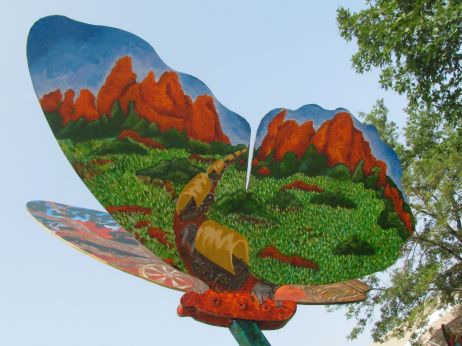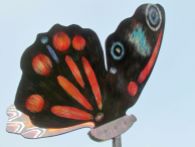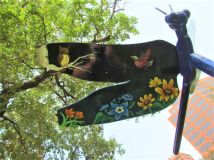Butterflies fly. As does time. Of these truths I was reminded when I realized that three years have lapsed since I first experienced a winged local late summer tradition. Contrary to countless canceled conventions worldwide, the Rotary Club of Colorado Springs’ annual gathering of famous lepidoptera was able to take place in 2020.
Some of you might remember my 2017 post Butterfly Fever, which celebrated the “Flight” event’s 10th anniversary. After having missed it in the intervening two years, earlier in September, on the lawn of Alamo Square Park which surrounds my favorite museum I recently introduced to you, I once again happily witnessed the delightful landing of 26 butterflies as well as dragonflies, which have also been part of the display since 2018.
To enlarge a photo, click on it. To read its caption, hover the cursor over it.
The artists selected by jury receive as their canvases empty metal insect shapes which they transform according to their fancy into creatures ranging from the slightly odd to the sublime. After being on display for nearly one month, they are sold in an art auction, whose proceeds “ensure children receive essential arts and science programs and also for community service projects throughout our city.”
Time and the fanciful insects have, indeed, flown, as this year’s virtual auction was held on September 26. The revenue will support worthy causes, and the generous patrons will be blessed with whimsical wings in their homes or gardens.
PS: The featured photo at the very top is “Flight of the Gods” by Diane Feller.
PPS: Dimensions of the artwork
Petite butterflies (not part of the al fresco exhibit) 7 x 9 inches
Medium butterflies 34 x 45 inches
Large butterflies 45 x 62 inches
Dragonflies 35 x 40 inches












I love these. Public art nods its head respectfully to nature and local history, and funds are raised for good causes. Everyone’s a winner!
LikeLiked by 2 people
That’s a wonderful summary of this fun project, Mr. P. Thank you!
LikeLiked by 1 person
The art works are real good. How extensive is your knowledge about butterflies compared to your knowledge about birds?
LikeLiked by 2 people
I think the butterflies’ creators are very talented artists. Neil. As far as my knowledge of butterflies, it’s very limited. I recognize only the most common ones, even though I would love to learn more about them.
LikeLiked by 1 person
Oh so beautiful! And what a great cause. Lovely to be reminded of our creative, generous side.
LikeLiked by 2 people
Very true, Laurie. We will gladly take all the reminders we can get.
LikeLiked by 1 person
Where English has butter, German has cream: “…Schmetterling has an interesting etymology. It derives from the east central German word schmetten, meaning ‘cream’, with the diminutive suffix -ling. It was believed that witches metamorphosed into butterflies to steal cream and other dairy products.” There are several theories about the yellow in the English name, including one akin to the German, but the explanation that seems to have held up the best is the one linking the name to the pale yellow of certain butterflies (even if many others aren’t yellow).
LikeLiked by 3 people
Thank you once again for elucidating the etymology of two more words for me, Steve. I had no idea. I will never be able to look at a butterfly or Schmetterling again the same way. 🦋
LikeLiked by 1 person
What stunning works of art!
LikeLiked by 2 people
I think so, too, M.B. And every year artists come up with beautiful new designs. It never gets boring.
LikeLiked by 1 person
Beautiful artwork! My favorite? The flight of the gods!
Kindest regards,
Christa
LikeLiked by 1 person
Thank you, Christa. Some very talented artists have been at work, I’m glad you enjoyed the results.
Have a good remainder of the week,
Tanja
LikeLiked by 1 person
How cool and beautiful. We have something similar here called “Art in the Orchard”. There is a clickable icon so you can see the exhibits. As I always avoid crowds even preCovid, I’ve not been there.
LikeLiked by 1 person
Thank you, Steve. I think it’s nice when art is made available to as many people as possible. Your “Art in the Orchard” looks like a lot of fun, too.
LikeLiked by 1 person
Maybe now, of all times, I’ll mask up and take it in. 🙂
LikeLiked by 1 person
I hope you will. It looks as though there is plenty of space to spread around.
LikeLike
These are lovely, Tanja. This year I have noticed less butterflies but more hummingbirds in the garden. We plant bushes that they like to feed on.
LikeLiked by 1 person
Thank you, Kerry. I think we have also had fewer butterflies this year, sadly. But planting for the bees, butterflies, and birds is a wonderful way to try to make up for all the expansive swaths of habitat that are destroyed by development.
Winged wishes,
Tanja 🦋🐝🐦
LikeLiked by 1 person
Our township gives out milkweed plants at spring time and we CANNOT cut down any tree!!! The giant live oak in our front garden is covered in bark lice web. They are a friendly insect who eat the damaging lichen on the tree. When they are finished they wrap up the web and move onto the next live oak. Isn’t that amazing?? K x
LikeLiked by 1 person
That IS amazing, Kerry. I love the idea of distributing milkweed and protecting trees. It likely can’t compensate for the wholesale destruction of expansive forests and fields of milkweed, but it’s a step in the right direction.
LikeLiked by 1 person
Every little step counts. Our township free magazine is very good at conservation tips and explaining how important all our critters are – from skunks to wood rats to snakes. That said, there are far too many cars. You win some, you lose some. 🌳🌳🌳
LikeLiked by 1 person
Let’s go with “every little step counts,” and hope that it will make a difference.
LikeLiked by 1 person
Zauberhaft, Tanja!
LikeLiked by 1 person
Dankeschön, liebe Brigitte, das waren sie. Inzwischen sind sie bereits weitergeflattert. 🦋
Beflügelte Grüße,
Tanja
LikeLike
How perfectly your photos juxtapose these stunning creations against the natural background of the park! I’m so happy you were able to experience this exhibit and I too am a fan of art outside of museums. Wishing you a wonderful October.
LikeLiked by 1 person
Thank you, I’m glad you enjoyed this beautiful display. I hope October will hold many happy moments for you.
Best,
Tanja
LikeLiked by 1 person
These are wonderful. A nearby town does the same with pelicans, although I will say the butterflies have one advantage over the birds; there’s more room for the artists to do their beautiful thing. I wondered about the name ‘tessellation,’ and found this: “A tiling or tessellation of a flat surface is the covering of a plane using one or more geometric shapes, called tiles, with no overlaps and no gaps.” I think the Queen Victoria Birdwing is gorgeous.
LikeLiked by 1 person
I think I remember your post about the pelicans, if I’m not mistaken.
Thank you for the definition of the word “tessellation.” I meant to, but forgot to look it up. I also liked the QV Birdwing with its colors and inlaid glass. If one looks closely, each butterfly hides a few special features.
LikeLiked by 1 person